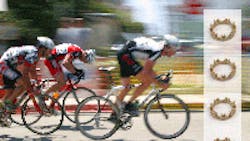High-performance bearings boost professional cycling speeds
Aug. 2, 2010
2 min read
In the highly competitive world of professional cycling where high friction can negatively influence race results, material properties including a low coefficient of friction, light weight, and top mechanical performance are critical. When it comes to one of the most important cycling components — bearing cages — the design and materials used are of paramount importance for cage performance as well as bearing reliability. For these reasons, ROS, a German manufacturer of high-performance plastic components, chose Victrex PEEK polymer from Victrex USA Inc., West Conshohocken, Pa., for a new line of bearing cages developed chiefly for sports applications.
Cages made from this polymer feature a formidable combination of strength and flexibility. The polymer's superior sliding properties and the smoothness of the cage surfaces (which are in contact with the rolling elements) generate little friction so that bearing wear is kept to a minimum. What's more, the material's low density means that cage inertia is small, which can contribute to quicker acceleration.
ROS recently formed a partnership with CeramicSpeed, a Danish company, who uses the cages made from PEEK polymer for professional racing bike bearings. Replacing standard bearings with higher performance versions offers several benefits for professional cyclists. For example, when used in the wheel hubs, they can reduce friction, which helps riders automatically accelerate faster regardless of speed. Also, by using the bearings in a bike’s bottom brackets, riders can increase speed, service life, and efficiency, because the bearings are lighter, smoother, and stiffer.
Bearing cages featuring this polymer have dramatically impacted the cycling world. During the 2009 Tour de France, nine out of 20 teams had bikes equipped with CeramicSpeed bearings. The 2008 Olympic Games were also a big success for athletes using the high-performance bearings in their equipment: A total of 17 medals were won by athletes whose equipment featured these bearings.
Regarding future applications, ROS and its Danish partner are targeting use in markets where high rotational speed bearings now dominate. ROS has also developed, along with another bearing manufacturer, the world’s largest bearing cage for a sustainable energy application; the bearing, which features Victrex PEEK polymer, has a diameter of 9.84 ft.
About the Author
Elisabeth Eitel
Elisabeth Eitel was a Senior Editor at Machine Design magazine until 2014. She has a B.S. in Mechanical Engineering from Fenn College at Cleveland State University.
Sign up for our eNewsletters
Get the latest news and updates
